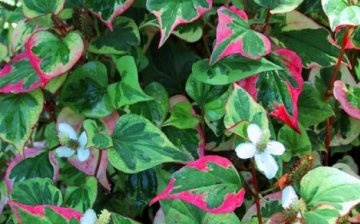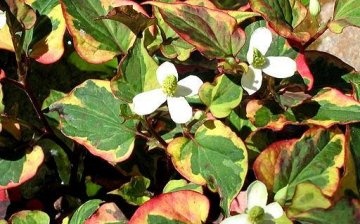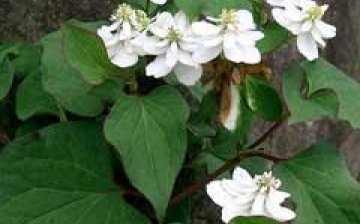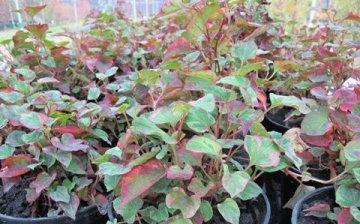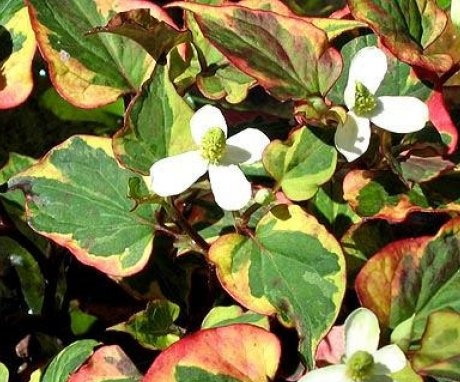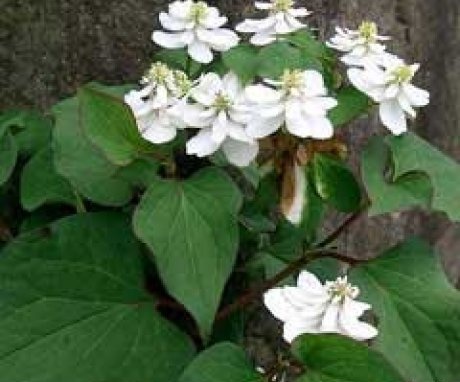Houttuynia heart-shaped - decorative leafy decoration of the garden
Most people grow not only fruits and vegetables in their backyard and summer cottage, but also plants that decorate it and delight those around them with their flowers or foliage.
Content:
Description of hauttuynia cordate
Houttuynia heart-shaped - decorative leafy a plant native to the Far Eastern coastal meadows. In Transcaucasia, it is found as a weed on tea plantations, and in Vietnam and China it is grown as a salad crop with a coriander flavor. In Russia, this plant has taken root relatively recently and is considered not edible, since it has an unpleasant odor that appears when damaged. In addition, the plant is used by the Chinese to heal many ailments, and the Japanese prepare a drink from it, brewing it like tea.
Houttunia got its name in honor of the Danish botanist Houttun. Until recently, the species Houttuynia cordate was the only representative of the genus Savrurah, but in 2001 a second species was discovered on the territory of China. It is called Houttunyia emeiensis and is not yet used in culture. Houttuynia is a perennial plant with thin roots spreading in the upper layers of the soil, as well as reddish stems and leaves that are similar in shape to ivy leaves. In the wild, it grows along the banks of water bodies, in the vicinity of swamps and in shallow water.
Houttuynia is prized for its brightly colored petiole leaves that include yellow, red and green shades with smooth transitions from one to the other. The green color adorns the center of the leaf, closer to the edges it turns into yellow, then into red. Most varieties of hauttuinia bloom with pleasant, cob-shaped, creamy white flowers with four petals, in the first half of summer, for a long time, but not abundantly.
Houttuynia care
It makes sense to grow hauttuynia heart-shaped only in sunny places, in the shade, like all decorative deciduous plants, it loses its variegation. The plant is not demanding on soil fertility, but loves moisture very much. Therefore, it should be watered frequently or grown near a body of water. in shallow water or in a swamp, if we are talking about a warm region. In the middle lane near the reservoir, the plant will die in winter. To prevent this from happening, it is recommended to transplant it into a pot and bring it indoors for the winter.
Houttuynia is a ground cover plant, whose rhizomes are capable of crawling even under concrete and throwing shoots away from the mother plant. Therefore, when planting, care must be taken to limit root growth, for example, using geotextiles or a plastic container without a bottom. Houttuynia is propagated by green cuttings and the division of rhizomes, which are planted in the soil to a depth of 5-10 cm. It is better to do this in the spring, so that the plant will strengthen before winter, increase the root and green mass. Houttuynia is sensitive to an excess of nitrogen in the soil, which negatively affects its winter hardiness.
In the middle lane, it is better to cover hauttuynia for the winter with spruce branches, sawdust, dry leaves, lutrasil, especially young specimens. In winters with little snow, they often freeze out.If this happened to your plant, do not rush to dig up the soil and throw out the roots, it is possible that the renewal bud, which will germinate in June, is not damaged on them.
Popular varieties
Most gardeners prefer the Chameleon variety, the leaves of which have the most variegated color with white, yellow and red spots scattered around the edges. The Pied Piper cultivar is also valued for its beautiful leaves, only their color is dominated by orange and yellow colors with a very small green vein. Houttuynia Plena has reddish stems and blue-green leaves, but very beautiful double flowers. Houttuynia Variegata blooms little, but its leaves are highly decorative and similar to those of the Chameleon variety.
Use in landscape design
Houttuynia is perfect for mixborders, rabatki and rock gardens. This short plant (up to 30 cm tall) is planted in the foreground to cover the wilting flowers and fill the voids between the flowering specimens. In spring, shoots appear late enough when most primroses finish flowering, so they are wonderful neighbors of this perennial in mixed flower beds. Houttuynias also look good against the background of decorative cereals, on the banks of artificial reservoirs with a humpbacked bridge.
In the middle lane, it is convenient to grow this ornamental deciduous plant as a container plant. In this case, for the winter, it is brought into a frost-free cellar or simply into a house, where it is cultivated as an ordinary houseplant until spring. It can be returned to the garden when the threat of spring return frosts has passed.



